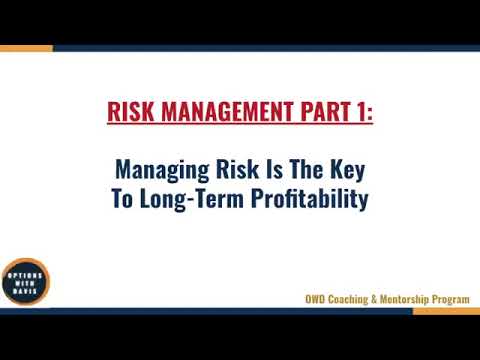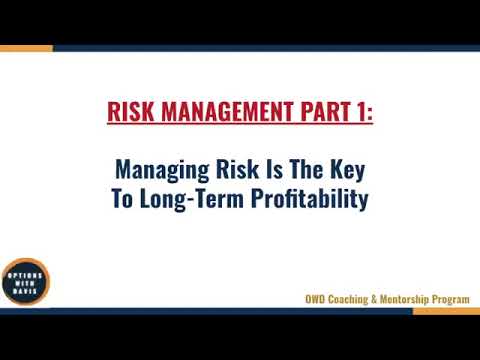Welcome to the first part of the risk management series! Out of all the videos in this program, the risk management videos are the ones you should truly pay attention to. Why? Because managing risk is crucial for your long-term profitability in trading. You see, when you sell options, you already have an inherent edge. However, there’s still risk involved. This risk becomes even more important to manage when you’re dealing with undefined risk options strategies. So, in this series, we’ll explore the key strategies and techniques for effectively managing risk, protecting your capital, and ultimately achieving long-term success in trading. So, let’s dive into the world of risk management and set a strong foundation for your trading journey!
Risk Management: The Key to Long-Term Success

Introduction
Welcome to the very first part of this risk management series! In this program, the risk management videos are some of the most important ones to watch repeatedly. Why? Because managing risk is crucial for your long-term profitability in trading. While selling options provides an inherent edge, there is still risk involved that needs to be effectively managed. This is especially true for undefined risk options strategies, which require careful planning and execution. In this article, we will explore the importance of risk management, the benefits of undefined risk strategies, and how to effectively manage risk in trading.
The Inherent Edge of Selling Options
When trading options, we already have an inherent edge when selling options. This edge comes from the fact that implied volatility (IV) is often greater than realized volatility, providing opportunities for profitable trades. However, it’s important to recognize that there is still risk involved in options trading, especially when using undefined risk strategies like short puts, strangles, and put ratio spreads.
Managing Risk for Consistency
Consistency in options trading is better achieved through undefined risk strategies. While these strategies offer higher probability of success, it’s crucial to effectively manage losing trades to ensure long-term profitability. One loss can potentially wipe out a significant portion of your profits or even your entire account. By implementing effective risk management strategies, you can mitigate the impact of losing trades and maintain consistency in your trading.
The Importance of Managing Outlier Risk
Outlier risk refers to major market events that can unexpectedly impact trades, such as a black swan event or a financial crisis. These events can cause significant losses if not properly managed. Traders who prioritize risk management are better prepared to handle such events and protect their capital. Even prop firms, which trade with their own funds, prioritize risk management to safeguard against large losses that could bankrupt the company. By being proactive in managing outlier risk, traders can minimize the impact of unexpected events on their trading performance.
Lessons from Prop Firms
As someone who was previously a prop trader, I learned firsthand the importance of risk management. Prop firms understand that managing risk is the key focus, as a single trader could potentially wipe out the firm if their risk is not properly managed. Prop traders have the advantage of not having any financial risk to their own capital since they are trading the firm’s money. This allows them to focus on managing risk and ensuring the firm’s long-term profitability.
The Story of a Senior Trader
Allow me to share a story from my time as a prop trader. There was a senior trader who had been with the firm for several years. His longevity at the firm indicated that he had been consistently profitable, as he had successfully covered the monthly desk fees with his profits. These desk fees are monthly charges that traders have to pay to the prop firm for using their computers, terminals, and workspace. If a trader is consistently unprofitable and unable to cover these fees, they may be asked to leave the firm.
One day, this senior trader got caught in a trade where he was long on a stock. Unfortunately, the market suddenly crashed due to unfavorable news for the company. Despite having a stop loss in place, it was not an immediate exit at the market price. It was based on volume size, which meant that once it reached a certain volume, the stop loss would be triggered. However, it still required hitting the bid to get out of the position.
The trader hoped that the market would take him out at a specific price, but the crash happened so quickly that he was unable to exit his position. The boss, who had monitors showcasing the risk of all the traders, could see that this senior trader had already hit his stop loss for the day. However, he had not exited his position. This raised alarms, as traders have a predetermined stop-loss amount based on their trading size and seniority. As soon as a trader hits their stop-loss for the day, it indicates that something is amiss.
Conclusion
In conclusion, risk management is crucial for long-term profitability in trading. While selling options provides an inherent edge, it’s important to recognize and manage the risks involved. Consistency in options trading is better achieved through undefined risk strategies, but effective risk management is essential for maintaining profitability. Outlier risk, such as major market events, must be considered and managed effectively. From the stories of prop firms and experienced traders, it’s clear that prioritizing risk management is vital to protect against large losses that could bankrupt a company or wipe out personal trading capital. By allocating a reasonable percentage of capital per trade, planning trade scenarios, and setting stop loss points, traders can effectively manage risk and increase their chances of long-term success. Remember, in options trading, evaluating risk should always be the main focus, not just profits.
